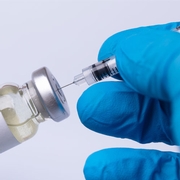Information you need to live a happy, worry-free retirement!
Originally published December 20, 2018, last updated January 2, 2019
Shortage of Shingles Vaccine Shingrix Expected Into 2019

Medical officials recommend that people age 50 and older get vaccinated against shingles, but you may have a difficult time finding the newest vaccine, Shingrix, because of a nationwide shortage.
After the Centers for Disease Control and Prevention (CDC) officially recommended Shingrix in January 2018 over the previous vaccine for people age 50 and older, demand surged, taking British drugmaker GlaxoSmithKline by surprise. The CDC reports that anticipated order limits and shipping delays will continue throughout 2019.
Why Your Age Matters With Shingles
Shingles is a viral infection that causes a painful, itchy rash. It can appear anywhere but often wraps around the left or right side of the torso. Caused by the varicella-zoster virus — the same virus that causes chickenpox — it lies inactive in nerve tissue near your spinal cord and brain after you’ve had chickenpox and can reactivate years later. While not life-threatening, a common complication is postherpetic neuralgia (PHN), severe pain that can linger weeks and even years after the rash clears up. A person’s risk of PHN increases with age. According to the CDC, one in three Americans will develop shingles in their lifetime, with the risk rising to half of adults older than age 85.
Zostavax, a single-dose shingles vaccine licensed by the U.S. Food and Drug Administration in 2006, had been recommended for healthy people age 60 and older. Zostavax was found to be about 51% effective. Shingrix, which is administered in two shots two months apart, is now the preferred vaccine, as it is 97% effective in healthy adults between ages 50 and 69 and 91% effective in adults 70 years or older, according to the CDC. Zostavax may still be used in certain cases, such as if a person is allergic to Shingrix, prefers Zostavax, or requests immediate vaccination and Shingrix is unavailable.
The surge in demand is due in part to the changed CDC’s recommendation, which lowered the age of suggested vaccination by a decade and touted Shingrix as the preferred drug. Shingrix’s manufacturer, GlaxoSmithKline, attributed the shortage to “unprecedented demand,” and has been ramping up production for months, according to NPR. It takes between six and nine months to be produced and get to market.
What to Do About the Shortage
While no one wants to endure the pain that shingles can inflict, don’t panic about the Shingrix shortage. There are about one million cases of shingles per year, according to the CDC, so your chance of developing it during the shortage is low.
If you haven’t been vaccinated for shingles yet, you may consider delaying your first dose until supplies are meeting demand, so that you don’t have to worry about the second dose’s availability. The CDC advises that you make every effort to get the second dose of Shingrix between two and six months after you get the first dose.
If your doctor or pharmacist is out of Shingrix, you can use the Vaccine Finder to find other providers. The CDC also updates its vaccines shortages page, and if you wish to be notified when it’s updated, you can enter you email on the page.
Is Shingrix Covered by Medicare?
Medicare Part A and B do not cover the shingles vaccine, but Medicare Part D plans do. There may be a co-pay for the vaccine, or you may need to pay in full then get reimbursed for a certain amount.
Medicare MarketPlace® Pharmacy Director Ryan Vlasin recommends getting your Shingrix shot at a pharmacy.
“Some physician offices can’t bill Part D, so getting the Shingrix vaccine at a pharmacy is the best way to confirm coverage and co-pay amount prior to getting the vaccine,” Vlasin said.
Most private health insurance plans cover the vaccine for people 60 years old or older. Some plans cover the vaccine for people age 50 through 59. The out-of-pocket cost will vary per plan.
The vaccine’s wholesale price is $140 per dose, but patients without insurance coverage will be paying more than that, sometimes as high as $200 or more for each shot after administration fees are added.
Shingrix Side Effects
Shingrix appears to be more likely to cause pain during injection and at the site of injection for up to three days afterward than Zostavax. The side effects in clinical trials also included injection site redness and swelling, muscle pain and immune system responses such as headache, shivering, fever and upset stomach.



